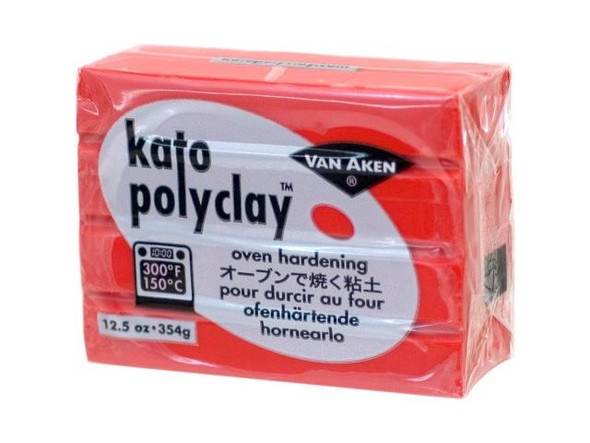Description
Polymer Clay Basics
Polymer clays are man made modeling materials that, once heat cured, become permanent and will not return to their original state. All are composed of the same basic components: plasticizers, resins, fillers and colorants.
Before using polymer clay it must be conditioned... kneading by hand until the clay is soft and pliable or fold and roll through a pasta machine. Inadequate conditioning will result in weakened finished items and weakened piece to piece adhesion. Condition light colors first, then move to darker colors.
Polymer clay pieces can be cured in a standard oven (convection) or toaster oven. Do not microwave polymer clay. If you don't have a dedicated oven, place items in an aluminum pan, then cover tightly with foil to prevent residue build up in your oven. Cure pieces in a well-ventilated area. Check oven accuracy with a thermometer and use a timer to avoid exceeding curing time.
The recommended curing temperature is 300° F (150° C). Kato Polyclay™ can be cured at 275° F (135° C) with good results and has been approved to cure at 350° F by our toxicologist, however caution should be taken when curing at that temperature, time should be limited to 10 minutes as you will run the risk of discoloration. You should never exceed 365° F.
Materials that will withstand clay curing temperatures, such as glass, paper mache, wood, metal and ceramic items may be covered with clay and baked in the oven. Items may be nested in polyester batting to avoid flat, shiny spots. Finished pieces may be painted or glazed after curing. Water-based paints and glazes are recommended. Cured clay may also be wet sanded (automotive sandpaper - 400 and 600 grit, in water) and then buffed to a high-gloss sheen.
Working Properties of Kato PolyClay™
1. Conditioning - Kato Polyclay™ is easy to condition, with no crumbling. I slice the blocks into 1/8" thick pieces. Roll through the pasta machine at the thickest setting. Finish by folding and rolling.
2. Handling - with continuous kneading and working, Kato Polyclay™ does not become sticky and, therefore, maintains its ease of workability.
3. Strength - Kato Polyclay™ was deemed as strong or stronger than other clays the testers used, - most feeling it was stronger. Not one single respondent found it to be less strong. Additionally, every color shares the same strength.
4. Color stability - From uncured to cured state, no Kato Polyclay™ color shifts more than 1/2 shade, with the majority remaining unchanged from uncured to cured state. It is virtually "true- color".
5. Consistency - Colors share the same consistency and softness. For example, you won't find white very hard and green very soft. Even consistency promotes even cane reduction, which results in less distorted imagery and less waste at cane ends.
6. Color Mixing - Rather than taking an academic approach (this requires that the user have a rather extensive knowledge of color mixing) we have opted for a more user friendly and intuitive method. The Spectral Colors form the basis for the creation of all colors. If they were placed on the color wheel, you would find them very evenly spaced. This approach makes color mixing simple for even the most inexperienced user.
7. Colors - Colors have been formulated for maximum purity and brilliance.
8. Finish - Once cured, Kato Polyclay™ exhibits a satin sheen.
9. Density - As part of the manufacturing process, Kato Polyclay™ is vacuum extruded (we are the only company utilizing this state of the art process). In essence, air from the clay is removed, making the clay denser and eliminating the need for continuous folding and rolling to remove air pockets from the clay.
10. Warm repositioning - Kato Polyclay™ is not as fragile as other brands when warm. Kato Polyclay™ allows for a measure of repositioning of elements when warm - the clay maintains its new position without breaking.
See Related Products links (below) for similar items and additional jewelry-making supplies that are often used with this item.
Details
Sold by: |
each |
Color: |
Blue |
Size: |
12-1/2 oz |
Country of Origin: |
United States |








